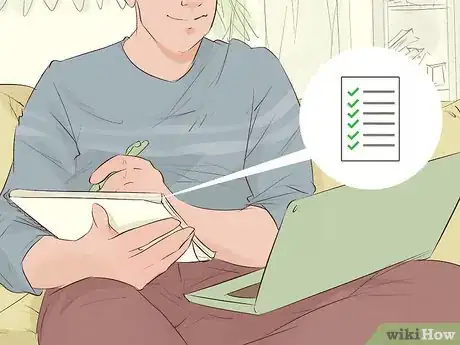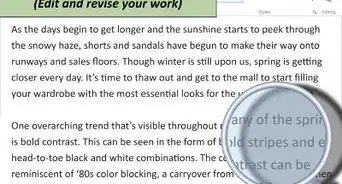wikiHow is a “wiki,” similar to Wikipedia, which means that many of our articles are co-written by multiple authors. To create this article, 14 people, some anonymous, worked to edit and improve it over time.
There are 7 references cited in this article, which can be found at the bottom of the page.
This article has been viewed 85,406 times.
Learn more...
For many aspiring journalists and writers, as well as seasoned veterans, sporting events provide a fruitful ground for practicing their craft. Sports are exciting, familiar, popular, unpredictable, and always happening somewhere. Be they for newspapers or websites or blogs, there are several typical forms of sports articles, from straight-up event recaps to feature profiles. Regardless of article type or sport covered, there are several methods, “do's" and “don’t's", and examples that can help someone who is new to sports writing.
Steps
Tackling Your Topic and Style
-
1Know the type of article you are writing. You may have an editor assigning your topic, or you may be a freelancer choosing your own. Regardless, be familiar with the most common forms of sports articles and determine which best matches your task. There are five types with which to be most familiar:[1]
- A “straight lede” (or “lead”) is a basic recap of a sporting event, providing the essentials on who played, who did what, and who won. They can be (but need not be) so formulaic that a computer can write them,[2] and are most common today for youth-level, high school, and small college events that are not shown or covered on TV/radio/internet.
- A “feature lede/lead” is more common for larger college and professional events where most of the readership already knows the score, but wants a more in-depth view of what happened and who made the difference in the result.
- A “profile” focuses on a colorful character or key figure such as a coach, star quarterback, or journeyman backup catcher with a love for practical jokes.
- A “season preview or wrap-up” either prepares the reader for the season to come or takes them on a tour of the highs and lows of the just-completed season. For instance, a baseball writer might file a preview during spring training and a best/worst summary after the end of the regular season (or playoffs).
- A “column” is an opinion piece where the sportswriter gets to express his/her opinions on (mostly) sports (mostly) freely. Aspiring sportswriters are likely to have fewer opportunities to write opinion columns than old pros who have proven their mettle over the years.
-
2Consult good examples of sports writing. Leaf through your local newspaper, favorite sports magazine, or go-to sports website and think about what makes certain articles stand out. How does the writer draw you in and make you feel like you were at the big game or in the locker room?
- Search websites for classic and modern examples of exceptional sports writing. [3]
Advertisement -
3Know as much as you can about the sport you are covering. Sports fans are known for their passion and not necessarily for their patience.[4] If you don’t know a sand wedge from a 5-iron or mention your admiration for “LaRon James’” passing skills, readers who know, love, and may have experience playing the sport covered will probably tune you out quickly.
- When you’re starting out, if you have the choice, cover the sport you know best. Master writing effectively about it before moving on to less familiar sports.
-
4Think about the reader. What would you want to know about this sporting event? Is the reader likely to already know the final score and who was the star of the game, or are you breaking the news? Write an article you would want to read as a fan of that sport.
Shooting for a Successful Sports Recap Article
-
1Go to the game, and make the most of being there. Watch closely. Take notes. Keep track of important plays, scores, and statistics. Take note of interesting details, such as how the players celebrated at the end or the feel of the crowd that night.
- Local sporting events are a good place to start for an aspiring sportswriter. You’ll find passionate fans/parents, eager participants, and a good environment for covering a sporting event from several angles.
-
2Talk to people there. Even if you are writing an event recap and not a personal interest story, a few good soundbites or a central figure to build the article around can only help.
- Contact coaches to see if they have a player who would make a good story. Watch the subject play the game, and set up a brief interview. Figure out what makes his or her story distinctive.
- Talk to players and coaches to get quotes about the game. Even asking boilerplate questions like “What contributed to you winning the game?” will give you some material with which to work.
- Ask permission to record your interviews. Also, try talking to people close to the person, such as parents and friends to create a well rounded view of the person.
-
3Sort out the essential details. Obviously you need to provide the final score and who did the scoring, but think about the most interesting statistics to come out of the event. How many passing yards did the quarterback have? Did the team’s star swimmer set a personal best in the backstroke? Was a long losing or winning streak broken?
-
4Start with a great hook. Known in journalistic circles as a lead (or lede), the opening lines of an article, sports-focused or otherwise, are critical to the success of the piece.[5] Leads should be short, direct, provide the most essential information, and compel the reader to keep going deeper into the article.
- Leads focus on the 5 “W’s” and “H” (who, what, when, where, why, and how). In a sports context, the score is always a great place to start. For example: “Last night in Falcon park, the air as crisp as winning quarterback Joe Smith’s passes, the Redview Falcons stunned the first-place Washington Coyotes in overtime, 56 to 54.”
-
5Flesh out the rest of the essentials. What was the best part of the game? What were the highlights? What made this game special? For a person, why is his or her story important? What makes them special? Use the quotes you got from players and coaches to add interest to the story.
- Consider the 4-step approach to a sports recap that begins with the lead, follows with more essential information, then adds a quote for flavor, then pushes out the rest of the details.[6]
- News article writing relies on an “inverted pyramid” structure, where the most substantial elements are found at the top of the article, and the information becomes less weighty and important as one approaches the bottom.[7] Readers always start but don’t always finish an article, so make sure they get your best stuff up front.
-
6Keep it concise. Even if you aren’t on an editor’s word count, one of the essential goals of all journalism, including sports writing, is to say as much as possible in as few words as possible. Even if you aren’t restrained by the space needs of a newspaper and are publishing online, your readers will appreciate it if you get to the point quickly. Use shorter sentences instead of longer ones.
Scoring with Other Kinds of Sports Articles
-
1Meet expectations. If you’re assigned a profile piece, conduct an in-depth interview and humanize the subject for your readers. If given the chance to write an opinion column, be bold and invite a reaction/response from readers. As mentioned in Method One, know what type of sports article you are writing and study best practices for success.
-
2Follow your passion. Writing is work, often very hard work. Try to remember why you wanted to write about sports in the first place. Think about what you love about sports and let it be reflected in your writing.
- If you are covering your alma mater in a basketball game or interviewing a pro golfer who happens to be a childhood hero, let your fan-dom be revealed. Sports are about passion, enthusiasm, and often silly biases. Be impartial with the facts but let readers see you as a sports fan as well as sports writer.
-
3Transport the reader. Most readers of sports articles have, at some point, dreamed of being at the plate with the World Series on the line or serving for the U.S. Open title. Even if they never reached that point, they probably remember what it’s like to grip the bat or toe the service line nervously. Find creative ways to make them feel like they were there at the event you’re covering, not just in the crowd, but on the field.
- For example, draw from interviews to place the reader at the foul line with the game on the line: “As she looked at the basket, trying desperately to block out the crowd behind it and the emptiness in front, Jane Davis could swear she caught a glimpse of her old garage wall holding up the hoop, felt the crumbling driveway beneath her feet, and sensed her Dad at her side.”
-
4Be a writer. Sports writing can sometimes get a bad rap as a lesser form of journalism, but some of the best writers and writing today and historically have covered sports. Hemingway famously wrote about bullfighting, and more recently, one of novelist David Foster Wallace’s most remembered pieces was about tennis star Roger Federer. Don’t sell yourself or your readers short, even if you are covering a youth soccer game. Those kids are giving their best, and so should you.
Community Q&A
-
QuestionWhat are examples of sports writing?
 DonaganTop AnswererSee ESPN.com or any sports magazine or newspaper.
DonaganTop AnswererSee ESPN.com or any sports magazine or newspaper.
References
- ↑ http://journalism.about.com/od/writing/a/sportsstories.htm
- ↑ https://www.merriam-webster.com/words-at-play/bury-the-lede-versus-lead
- ↑ https://ngscsports.com/2022/10/30/three-excellent-examples-of-sports-writing/
- ↑ https://www.viasport.ca/communications-toolkit/module-4-how-write-engaging-sports-article
- ↑ https://www.esu.edu/writing-studio/guides/hook.cfm
- ↑ https://www.youtube.com/watch?v=nra6ez9HZEk
- ↑ https://www.nngroup.com/articles/inverted-pyramid/
About This Article
To write a sports article, start by writing a short, catchy lead, or opening sentence, that mentions the final score and introduces key information that will compel the reader to go deeper into the article. Next, cover essential information like team names, the location of the game, the standout players, and a few other highlights. Then, sprinkle in a couple of quotes from the coaches or players and finish up by covering some of the important plays and any other interesting details. For tips on taking good notes at the game, read on!




































































